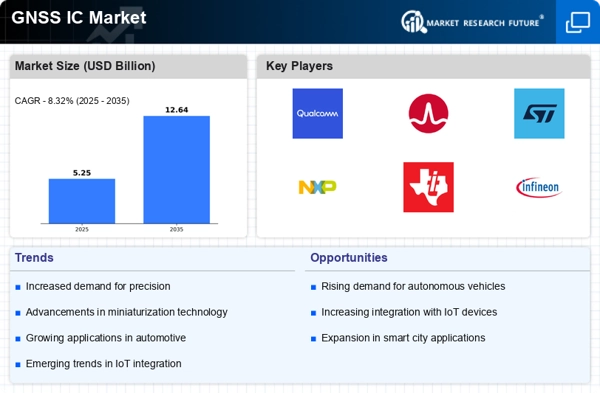Growth in Consumer Electronics
The GNSS IC Market is experiencing robust growth driven by the increasing integration of GNSS technology in consumer electronics. Devices such as smartphones, tablets, and wearables are increasingly incorporating GNSS ICs to provide location-based services and enhance user experiences. As of 2025, the consumer electronics market is projected to surpass USD 800 billion, with GNSS-enabled devices accounting for a significant share. The demand for navigation applications, fitness tracking, and location-based gaming is propelling the adoption of GNSS technology among consumers. Furthermore, advancements in miniaturization and cost reduction of GNSS ICs are making these technologies more accessible to manufacturers. As consumer preferences shift towards connected and location-aware devices, the GNSS IC Market is likely to see continued expansion in this segment.
Increased Adoption in Agriculture
The GNSS IC Market is witnessing increased adoption of GNSS technology in the agriculture sector, particularly in precision farming. Farmers are increasingly utilizing GNSS-enabled devices for tasks such as crop monitoring, soil analysis, and automated machinery guidance. The GNSS IC is projected to reach USD 12 billion by 2025, with GNSS ICs serving as a foundational technology for these applications. By leveraging accurate positioning data, farmers can optimize resource usage, enhance yield, and reduce environmental impact. This trend is further supported by the growing emphasis on sustainable agricultural practices and the need for food security. As the agriculture sector continues to modernize, the GNSS IC Market is likely to benefit from the rising demand for innovative solutions that improve efficiency and productivity.
Expansion of Smart City Initiatives
The GNSS IC Market is significantly influenced by the expansion of smart city initiatives across various regions. Governments and municipalities are investing heavily in infrastructure that incorporates GNSS technology to enhance urban planning, traffic management, and public safety. By 2025, the smart city market is expected to exceed USD 1 trillion, with GNSS ICs playing a crucial role in enabling real-time data collection and analysis. These systems facilitate efficient transportation networks, reduce congestion, and improve emergency response times. Moreover, the integration of GNSS with other technologies, such as IoT and big data analytics, enhances the functionality of smart city applications. As urban areas continue to grow, the demand for GNSS-enabled solutions within the smart city framework is likely to escalate, driving further growth in the GNSS IC Market.
Rising Demand for Precision Navigation
The GNSS IC Market experiences a notable surge in demand for precision navigation systems. This trend is primarily driven by the increasing adoption of GNSS technology in various sectors, including automotive, aerospace, and consumer electronics. As of 2025, the market for precision navigation systems is projected to reach approximately USD 5 billion, reflecting a compound annual growth rate of around 10%. The integration of GNSS ICs into smartphones and wearables further propels this demand, as consumers seek enhanced location-based services. Additionally, advancements in satellite technology and signal processing techniques contribute to improved accuracy and reliability, making GNSS solutions more appealing to end-users. Consequently, the GNSS IC Market is poised for substantial growth as industries increasingly rely on precise navigation capabilities.
Emerging Applications in Drones and UAVs
The GNSS IC Market is poised for growth due to the emergence of applications in drones and unmanned aerial vehicles (UAVs). The increasing utilization of drones for various purposes, including delivery services, aerial photography, and agricultural monitoring, necessitates precise positioning and navigation capabilities. The drone market is expected to reach USD 40 billion by 2025, with GNSS ICs being integral to the functionality of these systems. As regulatory frameworks evolve to accommodate drone operations, the demand for reliable GNSS solutions is likely to rise. Additionally, advancements in GNSS technology, such as multi-frequency and multi-constellation systems, enhance the performance of drones in challenging environments. Consequently, the GNSS IC Market stands to benefit from the growing adoption of drones across multiple sectors.















Leave a Comment